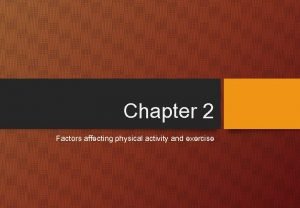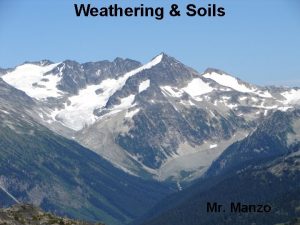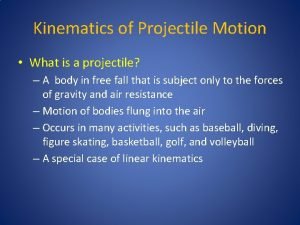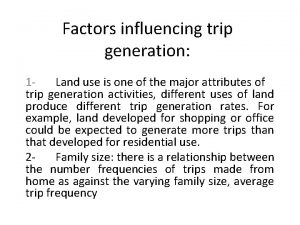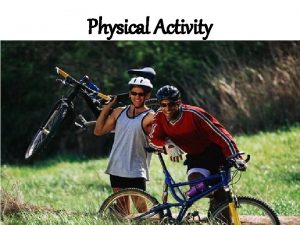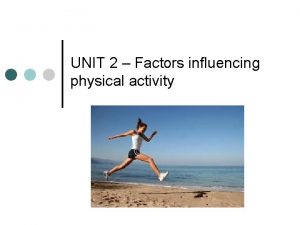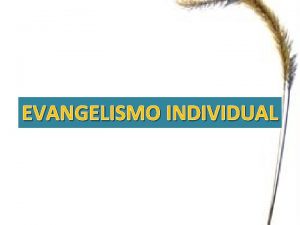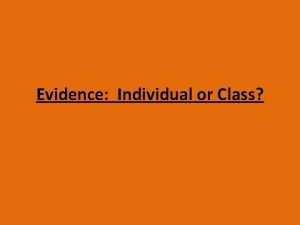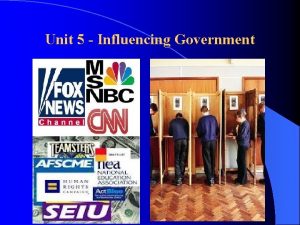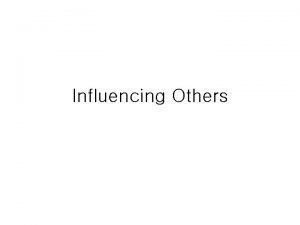FACTORS INFLUENCING PHYSICAL ACTIVITY Individual factors Demographic factors
















- Slides: 16

FACTORS INFLUENCING PHYSICAL ACTIVITY

Individual factors Demographic factors (e. g. age, gender, socioeconomic status) Understanding factors influencing participation in physical activity Barriers to physical activity Environmental factors Social environment Physical Environment

FACTORS INFLUENCING PHYSICAL ACTIVITY Individual and demographic factors Age ↑age = ↓ in physical activity Gender Males are generally more active than females – particularly in relation to vigorous activity Socioeconomic status (education and income) ↑income and/or final year of education = ↑ in physical activity Self-efficacy (self-esteem) ↑self-efficacy = ↑ in physical activity Cultural Background National Surveys conducted in Australia found that people from Non-English speaking backgrounds are at a higher risk of being inactive.

1. Record the percentage of: Males participating in sport Females participating in sport Australians participating in sport

2. Discuss factors which could account for the differences in the number of males compared to females participating in sport. 3. Identifying the need to engage adolescent girls in physical activity, programs are being developed in school settings to promote and encourage girls to be physically active. i. iii. Are there large numbers of females participating in sports at your school? Are girls in your school setting encouraged to be physically active? Discuss. What strategies could be used in the school setting to promote the involvement of girls in physical activity? Discuss.

Environmental factors Climate ↑sunshine and warm weather = ↑ in physical activity Time spent outdoors ↑time spent outdoors = ↑ in physical activity Access to equipment or facilities ↑access to equipment and facilities = ↑ in physical activity

Social environment Social and parental support ↑ support = ↑ in physical activity Dog ownership If you own a dog you are more likely to be physically active Parental modelling If your parents are physically active you are more likely to be physically active

Physical Environment Transport Easy transport access = ↑ in physical activity Parklands ↑parks = ↑ in physical activity Walking and cycling tracks ↑walking and cycling tracks = ↑ in physical activity Recreational facilities (skate parks, playgrounds etc. ) ↑recreational facilities = ↑ in physical activity

BARRIERS TO PARTICIPATION IN PHYSICAL ACTIVITY Barriers are generally considered factors that make it difficult to do something. https: //www. youtube. com/watch? v=M 70 ujp. NYq. P 4

CATEGORIES AND EXAMPLES OF BARRIERS Perceived Barrier Examples Time constraints and competing roles • • Being a parent or partner Caregiving of family members Occupational Roles within the relationships (picking up groceries, completing chores around the home/garden • Chronic diseases including diabetes, depression, back pain, injury or arthritis Individual (internal factors) • • External factors • Lack of self-efficacy, motivation, interest Lack of energy, due to fatigue Health problems Lack of social support from family, friends or partner Body weight or perception of appearance Personal physical and psychological health • • • Lack of local activity facilities, or transport to important destinations (e. g. beach, parks, fitness centre) Cost of programs and access to facilities Poor weather, hilly terrain or lack of

GENERAL REASONS PEOPLE ARE INACTIVE • Lack of time • Dislike of exercise • Feeling too tired • Lack of company • Lack of money

BARRIERS ACCORDING TO TYPE OF PHYSICAL ACTIVITY We cannot assume that the types of barriers to all forms of physical activity are the same. The barriers to walking may be different from the barriers to more vigorous activities such as jogging. Common barriers to vigorous physical activity include: Feeling self-conscious Lack of energy Disliking or discomfort associated with strenuous exercise Lack of financial resources.

POPULATION SPECIFIC BARRIERS • Males • Females • Youth and adolescents • Aged • Disabled • Rural locations • Urban locations • Diverse ethnic groups • Indigenous Australians • Overweight and Obese

CASE STUDY Yang, aged 24 years old, is a newly arrived immigrant from Vietnam. Yang is a dentist and travelled to Australia for a new job opportunity. She travelled to Australia alone and has no family here. Explain why Yang may find it difficult to be active initially. John, aged 47 years old, weighs 165 kg and is classified as obese for his 178 cm height. Describe 3 barriers John would need to overcome in order to be active.

OVERCOMING BARRIERS TO PHYSICAL ACTIVITY https: //www. youtube. com/watch? v=Rpf. Hg 6 Que 7 E How would you overcome the barriers of: Lack of time Lack of interest Lack of money Lack of health or fitness Lack of facilities Lack of motivation Weather conditions? Strategies to overcome barriers to physical activity should be specific to each population group or sub-group.

BARRIERS TO BEING ACTIVE QUIZ
 Physical factors influencing agriculture
Physical factors influencing agriculture Physical factors influencing agriculture
Physical factors influencing agriculture History of farming
History of farming Physical fitness grade 9
Physical fitness grade 9 Factors affecting physical activity
Factors affecting physical activity Meaning of dynamic personality
Meaning of dynamic personality Factors influencing chemical weathering
Factors influencing chemical weathering Objectives of wages
Objectives of wages How to compute the displacement
How to compute the displacement Nursing definition by nightingale
Nursing definition by nightingale Factors affecting trip generation
Factors affecting trip generation External factors influencing pricing decisions
External factors influencing pricing decisions A model of destination image formation
A model of destination image formation Factors influence communication
Factors influence communication Factors influencing maternal health
Factors influencing maternal health Local factors affecting wound healing
Local factors affecting wound healing Factors influencing faculty staff relationship
Factors influencing faculty staff relationship




